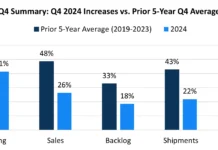by Ashley Turrell Burleson, operations support specialist
MAPP, Inc.
 More than 90 percent of plastics processing executives anticipate either steady or increased business activity for 2017, according to the recent State of the Plastics Industry Report from the Manufacturers Association for Plastics Processors (MAPP).
More than 90 percent of plastics processing executives anticipate either steady or increased business activity for 2017, according to the recent State of the Plastics Industry Report from the Manufacturers Association for Plastics Processors (MAPP).
In its 17th year, MAPP’s annual State of the Plastics Industry assessment shows that executives are predicting optimistic trends for plastics processors. Data for this report were collected from more than 150 senior-level executives representing companies of a variety of sizes and across an array of processing disciplines. This report helps company leaders benchmark how their companies stack up in comparison to industry norms and helps to calibrate the intuitive “gut feel” that most executives are looking to validate.
According to multiple indicators in this year’s report, partnered with outside economic indicators, the outlook for 2017 is shaping up to be fairly strong for the plastics industry. MAPP’s leadership team examined key questions from this year’s study to develop an overall forecast for what the plastics industry may look like in 2017.
Fifty-eight percent of processors indicated their companies’ fourth-quarter sales were up compared to third quarter – an increase of 18 percent from last year, and four percentage points higher than the 10-year average of 54 percent.
Troy Nix, MAPP executive director, elaborated: “The trend of this data point has generally served as a good indicator annually of the drive for the first six months. This increase suggests there is strong momentum going into the new year.”
 Thirty-four percent of plastics executives also reported an increase in fourth-quarter profits, up nearly 10 percent from the previous year. When looking at production, 97 percent of processors anticipate that first-quarter production work weeks will increase or remain about the same, and 96 percent believe the number of production employees will either increase or remain steady. The 2017 survey marks the first time in the past 10 years that fewer than four percent of plastics processing executives anticipate a decrease in the employee work week.
Thirty-four percent of plastics executives also reported an increase in fourth-quarter profits, up nearly 10 percent from the previous year. When looking at production, 97 percent of processors anticipate that first-quarter production work weeks will increase or remain about the same, and 96 percent believe the number of production employees will either increase or remain steady. The 2017 survey marks the first time in the past 10 years that fewer than four percent of plastics processing executives anticipate a decrease in the employee work week.
Sales also are anticipated to remain strong in the first quarter of 2017 and throughout the remainder of the year. Eighty-nine percent of processors believe first quarter sales will either increase or remain stable, and 94 percent predict that sales over the next 12 months either will remain the same or increase. This confidence comes from upcoming projects with current customers and developments with new customers. This anticipation isn’t just processor optimism – recent studies reveal that increased disposable income and consumer confidence are helping to boost the industry. According to international news outlet Reuters, consumer optimism about the economy peaked in December to the highest level since 2001. This information reinforces the positive predictions made by plastics executives.
With processors reporting new programs and increased volume from current customers, as well as the anticipated increase in sales, many are struggling to find the labor needed fulfill their needs. Over the past six years, plastics executives have rated workforce development issues (training, recruiting, retaining) as a top challenge facing their company. In 2012, 45 percent of processors indicated that workforce development issues were a top challenge; today, that number has more than doubled. As of January 2017, 92 percent of processors indicated that recruiting and training qualified workers were major barriers facing their organization.
Plastics executives are indicating various ways they plan to tackle this challenge – and most are not looking to invest large amounts of money into workforce development. Instead, many processors are turning to the growing automation and robotics industry to mitigate this challenge and improve their overall competitiveness.
 While only 14 percent of executives in this study indicated their companies were looking to invest in workforce development strategies to grow a sustainable workforce, more than one-fifth of participants (22 percent) indicated they were looking to invest in automation/robotics. Overall, this isn’t surprising, as 45 percent of processors believe this area is the one major technology trend that will impact the industry the most during 2017. Executives who are struggling to find qualified, dedicated and skilled workers are finding a greater reliance on automation can eliminate some of the frustration experienced with the lack of available workers.
While only 14 percent of executives in this study indicated their companies were looking to invest in workforce development strategies to grow a sustainable workforce, more than one-fifth of participants (22 percent) indicated they were looking to invest in automation/robotics. Overall, this isn’t surprising, as 45 percent of processors believe this area is the one major technology trend that will impact the industry the most during 2017. Executives who are struggling to find qualified, dedicated and skilled workers are finding a greater reliance on automation can eliminate some of the frustration experienced with the lack of available workers.
Additionally this year, the current MAPP report includes new data based on responses from previous studies, such as customer demands for financials, trends by industry served, plans to improve overall competitiveness and insights from industry experts. With all things considered, a steady, positive outlook appears to be on the horizon for plastics processors.
For more information or to purchase the report, visit www.mappinc.com. Join MAPP on March 2 for the State of the Plastics Industry webinar by first registering on the Events page of the MAPP website.




